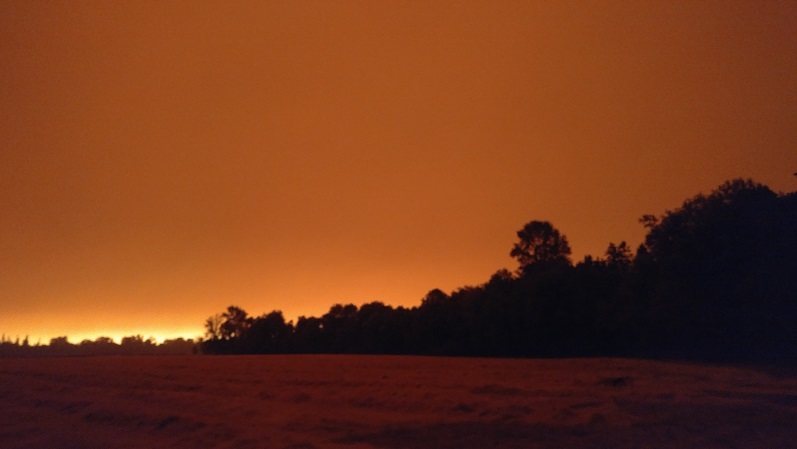Brad Withrow-Robinson, OSU Forestry & Natural Resources Extension agent for Benton, Linn and Polk Counties. First appeared in Linn & Benton Extension July/August GROWING newspaper.
Wildfire is an accelerating problem across Oregon, with many potential impacts. One impact – smoke – can have many detrimental effects on communities including our physical and mental health, damaging our forest and agricultural industries, and slowing local economies.
Harmful smoke from wildfire happens somewhere in Oregon every year, and in years like last year, spares no part of the state.

Smoke filled sky outside of Albany, September 8, 2020. Photo Brad Withrow-Robinson
The 2020 wildfire season showed us how important it is for Oregonians to protect themselves from smoke and how there is an opportunity to build smoke readiness across our state. During 2020’s unprecedented smoke event, people scrambled to find information about how to protect themselves, their families or their employees from the smoke. They had questions like: “What types of masks are adequate?” “How do I keep air in my home clean?” “Is my furnace air filter adequate?” Or, they wanted to know if food from their garden would be safe to eat, and how to clean it. It is important that Oregonians have access to reliable information in clear and understandable language.
Last year taught us many lessons, including that we need to be better prepared to protect ourselves from smoke.
We need to recognize that smoke is part of life here in the Pacific Northwest. Oregon communities need to be both fire and smoke ready.
But what does a smoke ready community look like? How do we get there?
Those are questions that OSU Forestry & Natural Resources Extension is asking in its new “Smoke Ready Communities” group project, which aims to help improve communities’ readiness and resilience to the impacts of smoke, with the goal of reducing the health and economic impacts of smoke.
To do so we will be working on several steps:
- Better understand the health risks and impacts of smoke exposure
- Identify effective methods to reduce risks and impacts of smoke exposure
- Learn about the information and communication needs and preferences of communities throughout Oregon.
- Effectively communicate about the risks, and about actions that can be taken to reduce harm
The Extension project is now tackling the first three items, and convening a team of partners. We are working with researchers from OSU & UO, as well as state agencies like the Oregon Department of Environmental Quality and Oregon Health Authority among others, to identify the best science-based information on the effects of smoke, the effectiveness of interventions, as well as how to get the information to the people and organizations who need it. As we move forward, the partnership will expand to include local government and community organizations and shift towards providing outreach and educational resources to share that information for the biggest impact possible.
So what does a smoke ready community looks like? We know it involves many things, including the capacity to monitor air quality, to communicate with citizens and businesses about risks and how to address them and, to provide help in preparing at the individual and community level.
Communities around the state differ greatly in their vulnerability to smoke issues (because of their location, demographics, and economies) and also in their capacity to respond. Each community’s responses will be unique, even while sharing many things in common.
For an example of what a smoke ready community effort looks like (in progress), take a look at what the city of Ashland is doing
Take action! Here are three things you can do to prepare for smoke season.
- Visit Ashland’s smokewise page and look at “how to create healthy indoor air”. Now is the time to get ready and buy any filters or air purifiers you need for your home!
- Visit and bookmark the Oregon Smoke Blog site (in English y Español), an important source of information from Oregon wildfire smoke preparedness team.
- Visit the Oregon Health Authority wildfires page to learn more (in many languages) about the health effects of wildfire smoke and steps to protect yourself and your loved ones.
Watch this space for more information about and from the Smoke Ready Communities project as the project progresses.
